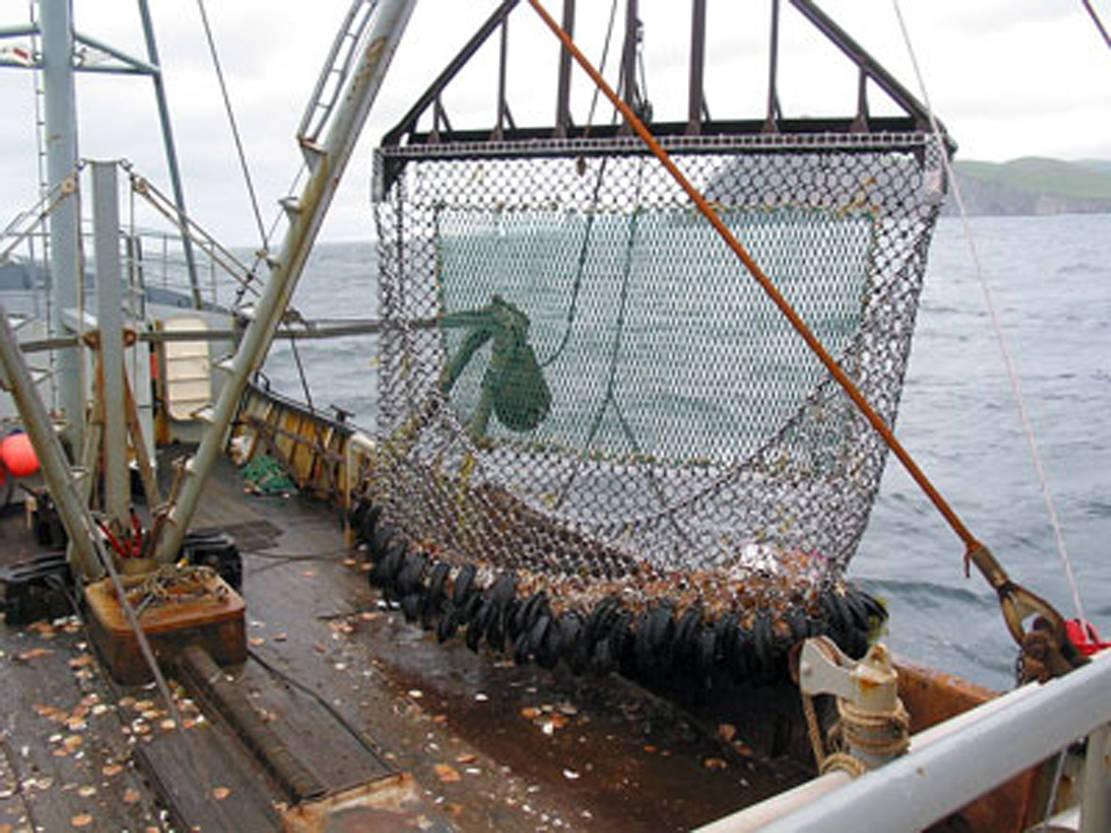A lot of Alaska’s scallops are sick, and scientists are trying to figure out why.
Alaska’s scallop fishery is a small one — in recent years, four boats, with just one operating in Kamishak Bay in Lower Cook Inlet. The rest operate out of Kodiak. Most scallop beds straddle the three-nautical mile line between state and federal management areas and is jointly managed by the National Marine Fisheries Service and the Alaska Department of Fish and Game. The permit system is attached to vessels rather than to individuals, restricting the entire fishery to nine vessels total under the federal system. Together, their 10-year average landing poundage of shucked meats is about 383,000 pounds, for total value of about $4 million, according to a report submitted to the North Pacific Fishery Management Council by the Scallop Plan Team.
But in recent years, the fishermen have had to start tossing a lot back. When they pull them up, a lot show signs of degraded meat with brown spots and a stringy texture and will occasionally slip off the shells at the processor. The condition, called “weak meats,” results in a lot of waste in the scallop fishery, as processors aren’t interested in buying scallops with weak meats.
“Weak meats are a very general term for the adductor muscles … being of a very low quality, very easy to tear,” said Quinn Smith, the Southeast Region fishery management biologist for Fish and Game in a report to the council on April 5. “High prevalence in 2014, 2015 was somewhere on the order of half of all scallops shucked couldn’t be marketed. That was much higher than the fleet had ever seen before.”
In response to increasing reports of infected scallops, Fish and Game observers on board scallop fishing vessels began collecting samples for evaluation. The observers took samples primarily from one area in 2014 and then spread to statewide sampling in 2015 to get an idea of how widespread the infection is.
Fish and Game’s pathology labs identified about 82.2 percent of the scallops with the presence of the parasite, called an apicomplexan parasite. The condition doesn’t seem to be harmful to humans, only to scallop meat quality, and not all scallops infected show the symptoms — it depends on the intensity of the infection, according to the pathology report.
However, similar parasites in other scallop populations have caused trouble before. Fish and Game’s pathology report mentions that a similar parasite was found in Icelandic scallops and Atlantic sea scallops from the Atlantic waters of Canada and the U.S. No commercial fishing has been allowed on Iceland’s scallop stocks since 2003 because of concerns about the stock, and a 2015 paper published in the scientific journal PLOS One asserts that there is a strong correlation between the presence of the pathogen and mortality and sexual reproduction in the stocks, causing further decline.
Intensity varies across the seven registration areas of Alaska, from very prevalent in the Bering Sea and Shelikof Strait near Kodiak to much less prevalent in the Yakutat area, Quinn said.
Scallop catches have been declining somewhat, with more effort required to catch the same poundage. Some areas are doing better than others, with areas like Yakutat holding fairly steady while Shelikof Strait is much lower than it has been in the past, Quinn said in his report. However, Fish and Game doesn’t know enough yet to pin down whether the presence of the parasite is what’s causing declines.
“Is this the explanation of what’s happened with the decline of the fishery? We don’t know,” Quinn said. “Is it a possibility that is going to continue to be followed up? Absolutely.”
The scallop fishery isn’t overfished in Alaska, said Jim Armstrong, the plan coordinator for the North Pacific Fishery Management Council and vice chair of the Scallop Plan Team.
“We’re miles away from the overfishing limit,” he said. “That’s not really been an issue.”
The North Pacific Fishery Management Council adopted the Scallop Plan Team’s proposed acceptable biological catch limit of 1.16 million pounds at its April 6 meeting in Anchorage. The discard mortality is accounted for within the managers’ recommendations, so the discards come out of the fishermen’s bottom lines, Quinn said. They deal with this by moving away from a scallop bed when the catch looks to be poor quality, he said.
“We didn’t have any members of the scallop fleet at the meeting a couple of weeks ago, but they definitely are (concerned), and you see it in the fleet behavior,” he said.
Fish and Game plans to continue researching the disease, but it depends on funding, Quinn said. The researchers in Alaska are also conversing with researchers on the East Coast looking into the parasite in scallops there. The pathology report submitted to the council recommends not discarding back into the sea on the fishing ground because the parasite seems to be directly transmissible from individual to individual.
“However, this may not be practical or economically feasible without some incentive program,” the report states. “Treating the offal prior to discarding at sea could also be considered, but again this carries a cost.”
Reach Elizabeth Earl at elizabeth.earl@peninsulaclarion.com.

